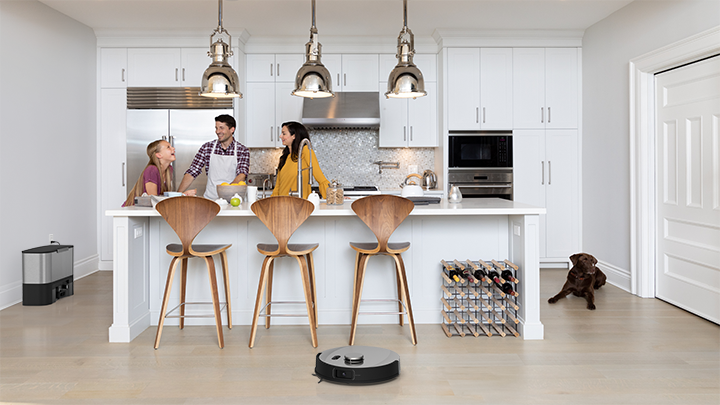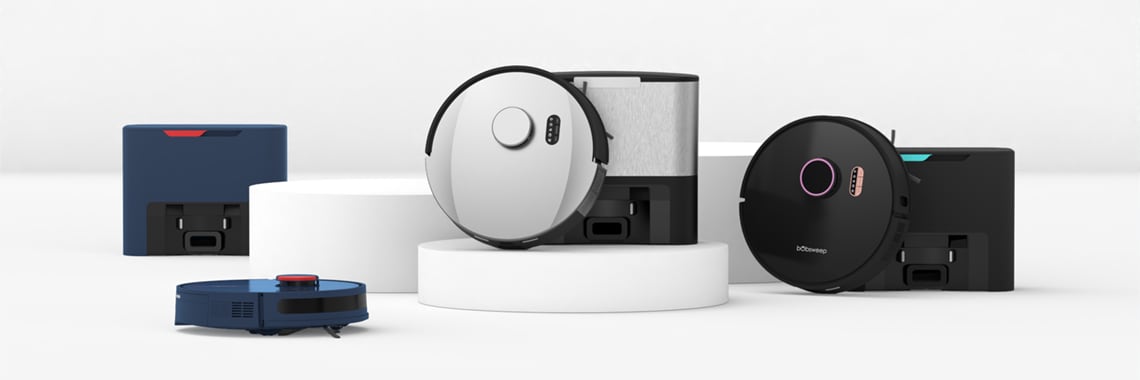Robotic vacuums have surged in popularity over the past decade, thanks to their ability to keep homes clean without the hassle
of manual vacuuming. These robots utilize spatial computing algorithms for navigation, broadly referred to as SLAM, an
abbreviation for simultaneous localization and mapping. Traditionally SLAM is processed on powerful embedded processors.
However, the introduction of NXP’s crossover microcontroller units (MCUs) signals a new breed of these devices that deliver the
real-time performance, power efficiency and connectivity required to navigate and clean residential and commercial spaces more
efficiently.
Since 2011, bObsweep has developed a range of
intelligent floor-cleaning robots that help keep homes spick and span. Its product portfolio includes several models that target
a variety of needs and price points (for example, PetHair, Dustin and Ultra-Vision).
bObsweep's PetHair-based models are designed for homes with pets. They use a combination of sweeping, vacuuming and mopping to
remove dust and debris from various floor types. Building on the PetHair model, the upgraded Dustin adds features like
self-emptying, Wi-Fi connectivity, smartphone app control and a larger battery for extended-cleaning sessions. bObsweep’s
flagship robotic vacuum, the Ultra-Vision, takes cleaning to new fronts with the industry’s largest dust collector, an onboard
camera and real-time computer vision processing for advanced low-height item detection and obstacle avoidance. Exceptionally
agile, bObsweep’s Dustin and Ultra-Vision models boot in just 6 seconds, map on the fly without the need for training runs,
identify the floor layout at first glance and react to the environment at very high speed.
 bObsweep vacuum at work in a modern home.
Image credit: bObsweep
bObsweep vacuum at work in a modern home.
Image credit: bObsweep
How Crossover MCUs Can Benefit Robotic Vacuum Applications
Historically, robot vacuums have relied on hefty CPUs in addition to one or multiple discrete MCUs to handle processing
workloads, increasing cost, complexity and power consumption. However, a new class of processors known as “crossover MCUs” can
support robot vacuums by combining the high performance and integration of application-specific chips with the real-time
capabilities and ease-of-use of conventional MCUs. bObsweep is leveraging this innovation to consolidate multiple vacuum
functionalities into a single-chip solution (NXP’s
i.MX RT1052 crossover MCU). This serves as the
vacuum’s cost-effective, yet highly accurate, brain.
Ordinarily, the various functions in a robot vacuum have been achieved by employing multiple dedicated processors. A typical
architecture comprises separate MCUs for low-level motor and sensor control, high-level compute CPU for navigation, discrete
wireless radio chips and more. However, spreading workloads across multiple chips increases the cost, complexity and points of
failure. Multichip systems also consume more PCB real estate, limiting design flexibility.
To deliver a superior user experience and the best value to their customers, bObsweep took a different approach to designing its
products’ hardware and software.
Elevate your applications with advanced processing and efficiency. Learn more about how the powerful
i.MX RT1052 crossover MCU.
The “Right Chip” for the Job
The i.MX RT1052 is part of NXP's crossover MCU series combining the high performance and integration of application processors
with real-time capabilities and ease-of-use of conventional MCUs. This MCU contains an Arm® Cortex®-M7 running at up to 600 MHz,
providing ample computing power to handle low-level real-time tasks, such as motor control, sensor fusion and navigation
planning. NXP’s i.MX RT1050 crossover MCUs also provide a CSI interface, which is used to control the CMOS sensor, and up to 1
MB of tightly coupled memory to allow the entire processing to be contained onboard.
Connectivity and Interfacing
Robotic vacuums use a variety of interfaces to connect sensors, actuators, wireless modules and other peripherals. The i.MX
RT1052 handles all of these with an extensive set of integrated I/O options, including:
- Multiple I²C, SPI and UART ports for sensor interfacing
- Up to 12 PWM channels for brushless DC motor control, audio and display interfaces
- USB/CAN connectivity for external modules
Advanced Graphics and Computer Vision
The Ultra-Vision is bObsweep's most sophisticated and intelligent robotic vacuum to date, setting a new standard for cleaning
performance and obstacle avoidance. However, even with advanced features like visual object detection, the Ultra-Vision still
only requires a single i.MX RT1052 chip to handle all processing tasks. The i.MX RT1052 enables the Ultra-Vision to see and
react to obstacles faster than any other robotic vacuum on the market while still maintaining a compact, cost-effective
processor architecture. This is the secret sauce behind bObsweep’s highly affordable prices for very high-end products.
A parallel 8-/16-bit camera interface allows direct connection to raw Bayer image sensors at up to 720p resolution and 60 fps.
The i.MX RT1050 crossover MCUs integrated Pixel Processing Pipeline (PXP) hardware offloads image preprocessing tasks, including
color space conversion, scaling, alpha blending and rotation. The PXP can manipulate images on the fly without CPU intervention.
Combining a camera interface and PXP allows bObsweep to integrate computer vision into its vacuums cost-effectively. The camera
feed is processed instantly to detect and identify objects in the robot’s path without using an external vision processor or
GPU.
Power Management and Efficiency
Battery-powered devices like robot vacuums demand the utmost efficiency to maximize runtime between charges. The i.MX RT1052
excels in low-power applications.
The chip includes an integrated power management IC with a high-efficiency DC-DC converter that powers the MCU and external
components, reducing the need for external power management circuitry. Low-power modes allow the CPU clock speed and core
voltage to be throttled during periods of light load, and full deep sleep mode can achieve current consumption as low as 4.6 mA
while still maintaining SRAM content and GPIO state. The i.MX RT1052 MCU also provides flexible clock gating for peripherals,
allowing unused modules to be automatically shut off to eliminate leakage.
Development Platform
NXP has gone to great lengths to simplify the development of the i.MX RT with a comprehensive software and tools ecosystem. Its
MCUXpresso SDK includes project files for MCUXpress for VS code, MCUXpresso IDE, Keil MDK and IAR Embedded Workbench. Support
for FreeRTOS™ on the i.MX RT1050 crossover MCUs is also available.
In addition, the i.MX RT series is also supported by the Zephyr Project, offering developers a full-featured, widely tested,
secure RTOS with a flexible licensing model. Zephyr's modular architecture and robust device driver infrastructure make it easy
to tailor the OS to fit the specific needs of robotic vacuum applications.
Configuration tools for setting up pin muxing, clock trees and power sequences eliminate much of the work during product
development.
Sweeping the Competition
With NXP's i.MX RT1050 crossover MCU as the
foundation for its platform, bObsweep delivered a family of robotic products that provides high performance, efficiency and
intelligent features. The i.MX RT1052 is an ideal “brain” for robotic vacuums, with its architecture offering high-speed
control, real-time operation, advanced processing and reliable connectivity.




